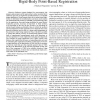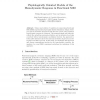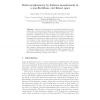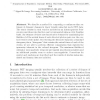108
Voted
IPMI
1999
Springer
15 years 5 months ago
1999
Springer
—Guidance systems designed for neurosurgery, hip surgery, spine surgery and for approaches to other anatomy that is relatively rigid can use rigid-body transformations to accompl...
109
Voted
IPMI
1999
Springer
15 years 5 months ago
1999
Springer
Three dimensional models of anatomical structures are currently used to aid in medical diagnosis, treatment, surgical guidance, and surgical simulation. Limitations on the resolut...
125
Voted
IPMI
1999
Springer
15 years 5 months ago
1999
Springer
Today, most studies of cognitive processes using functional MRI (fMRI) experiments adopt highly flexible stimulation designs, where not only the activation amount but also the tim...
102
Voted
IPMI
1999
Springer
16 years 1 months ago
1999
Springer
Inspired by the discussion in neurological research about the callosal fiber connections with respect to brain asymmetry we developed a technique that measures distances between br...
100
click to vote
IPMI
1999
Springer
16 years 1 months ago
1999
Springer
We describe the use of truncated multipolar expansions for producing dynamic images of cortical neural activation from measurements of the magnetoencephalogram. We use a signal-sub...
IPMI
1999
Springer
16 years 1 months ago
1999
Springer
117
click to vote
IPMI
1999
Springer
16 years 1 months ago
1999
Springer
Abstract. Automatic and semi-automatic magnetic resonance angiography (MRA) segmentation techniques can potentially save radiologists large amounts of time required for manual segm...
IPMI
1999
Springer
16 years 1 months ago
1999
Springer
One of the major drawbacks of Magnetic Resonance Imaging (MRI) has been the lack of a standard and quantifiable interpretation of image intensities. This causes many difficulties i...
138
click to vote
IPMI
1999
Springer
16 years 1 months ago
1999
Springer
The estimation of soft tissue deformation from 3D image sequences is an important problem in a number of fields such as diagnosis of heart disease and image guided surgery. In thi...
93
Voted
IPMI
1999
Springer
16 years 1 months ago
1999
Springer
Abstract. We describe a method for computing a continuous time estimate of dynamic changes in tracer density using list mode PET data. The tracer density in each voxel is modeled a...




